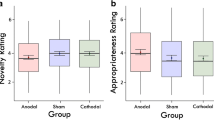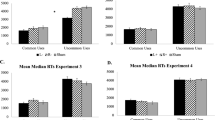Abstract
The left angular gyrus (AG), part of the frontotemporal network, is implicated in creative thinking, including verbal creativity tasks such as novel metaphor generation. The current study tested the effects of tDCS over the left AG on two metaphor generation tasks. The study was a randomized, double-blind, sham-controlled, crossover study of anodal vs. cathodal stimulation by tDCS. Compared to sham, cathodal stimulation resulted in significantly increased novel metaphor generation, while anodal stimulation increased conventional metaphor generation. Higher motivation (behavioral approach system’s “fun-seeking”) was associated with greater metaphor creativity in the sham condition, and lower fun seeking was associated with producing a greater quantity of conventional metaphors. Following active stimulation, motivation traits no longer contributed to creative metaphor generation. Thus, the beneficial effect of cathodal tDCS over the left AG in generation of novel metaphors is through restraining the control network. The current study gives a glimpse into the neural basis for creative thinking.


Similar content being viewed by others
References
Abraham A (2014) Creative thinking as orchestrated by semantic processing vs. cognitive control brain networks. Front Hum Neurosci 8:95
Andrews-Hanna JR (2012) The brain’s default network and its adaptive role in internal mentation. The Neuroscientist 18(3):251–270
Baer J, Kaufman JC (2008) Gender differences in creativity. The J Creat Behav 42(2):75–105
Bambini V, Gentili C, Ricciardi E, Bertinetto PM, Pietrini P (2011) Decomposing metaphor processing at the cognitive and neural level through functional magnetic resonance imaging. Brain Res Bull 86(3–4):203–216
Basadur M, Graen GB, Green SG (1982) Training in creative problem solving: effects on ideation and problem finding and solving in an industrial research organization. Organ Behav Human Perform 30(1):41–70
Beaty RE, Silvia PJ (2013) Metaphorically speaking: cognitive abilities and the production of figurative language. Memory Cogn 41(2):255–267
Beaty RE, Benedek M, Wilkins RW, Jauk E, Fink A, Silvia PJ, Neubauer AC (2014) Creativity and the default network: a functional connectivity analysis of the creative brain at rest. Neuropsychologia 64:92–98
Beaty RE, Benedek M, Kaufman SB, Silvia PJ (2015) Default and executive network coupling supports creative idea production. Scientific Reports 5:10964
Beaty RE, Benedek M, Silvia PJ, Schacter DL (2016) Creative cognition and brain network dynamics. Trends Cogn Sci 20(2):87–95
Benedek M, Mühlmann C, Jauk E, Neubauer AC (2013) Assessment of divergent thinking by means of the subjective top-scoring method: effects of the number of top-ideas and time-on-task on reliability and validity. Psychol Aesthet Creat Arts 7(4):341
Benedek M, Beaty R, Jauk E, Koschutnig K, Fink A, Silvia PJ, Neubauer AC (2014) Creating metaphors: the neural basis of figurative language production. NeuroImage 90:99–106
Binder JR, Desai RH (2011) The neurobiology of semantic memory. Trends Cogn Sci 15(11):527–536
Binder JR, Desai RH, Graves WW, Conant LL (2009) Where is the semantic system? A critical review and meta-analysis of 120 functional neuroimaging studies. Cereb Cortex 19(12):2767–2796
Buckner RL, Andrews-Hanna JR, Schacter DL (2008) The brain’s default network: anatomy, function, and relevance to disease. Ann NY Acad Sci 1124:1–38
Carver CS, White TL (1994) Behavioral inhibition, behavioral activation, and affective responses to impending reward and punishment: the BIS/BAS Scales. J Pers Soc Psychol 67(2):319–333
Carver C. S. and White T. L. (2013). Behavioral avoidance/inhibition (bis/bas) scales. Retrieved from the measurement instrument database for the social science. https://www.midss.org
Christensen PR, Guilford JP, Wilson RC (1957) Relations of creative responses to working time and instructions. J Exp Psychol 53(2):82
Clemens B, Jung S, Mingoia G, Weyer D, Domahs F, Willmes K (2014) Influence of anodal transcranial direct current stimulation (tDCS) over the right angular gyrus on brain activity during rest. PLoS ONE 9(4):e95984
Dietrich A, Haider H (2017) A neurocognitive framework for human creative thought. Front Psychol 7:2078
Finke RA, Ward TB, Smith SM (1992) Creative cognition: theory, research, and applications. MIT Press, Cambridge, MA
Gandiga PC, Hummel FC, Cohen LG (2006) Transcranial DC stimulation (tDCS): a tool for double-blind sham-controlled clinical studies in brain stimulation. Clin Neurophysiol 117(4):845–850
Gonen-Yaacovi G, Cruz de Souza L, Levy R, Urbanski M, Josse G, Volle E (2013) Rostral and caudal prefrontal contribution to creativity: a meta-analysis of functional imaging data. Front Human Neurosci 7:465
Green AE, Kraemer DJM, Fugelsang JA, Gray JR, Dunbar KN (2010) Connecting long distance: semantic distance in analogical reasoning modulates frontopolar cortex activity. Cereb Cortex 20:70–76
Green AE, Cohen MS, Raab HA, Yedibalian CG, Gray JR (2015) Frontopolar activity and connectivity support dynamic conscious augmentation of creative state. Hum Brain Mapp 36:923–934
Green AE, Spiegel KA, Giangrande EJ, Weinberger AB, Gallagher NM, Turkeltaub PE (2017) Thinking cap plus thinking zap: tDCS of frontopolar cortex improves creative analogical reasoning and facilitates conscious augmentation of state creativity in verb generation. Cereb Cortex 27:2628–2639
Greicius MD, Supekar K, Menon V, Dougherty RF (2009) Resting-state functional connectivity reflects structural connectivity in the default mode network. Cereb Cortex 19:72–78
Hayes MHS, Patterson DG (1921) Experimental development of the graphic rating method. Psychol Bull J 18:98–99
Hoddes E (1971) The history and use of the Stanford sleepiness scale. Psychophysiology 9:150
Jung RE, Mead BS, Carrasco J, Flores RA (2013) The structure of creative cognition in the human brain. Front Human Neurosci 7:330
Kapur N (1996) Paradoxical functional facilitation in brain-behaviour research: a critical review. Brain 119(5):1775–1790
Karok S, Witney AG (2013) Enhanced motor learning following task-concurrent dual transcranial direct current stimulation. PLoS ONE 8(12):e85693
Kasirer A, Mashal N (2014) Verbal creativity in autism: comprehension and generation of metaphoric language in high-functioning autism spectrum disorder and typical development. Front Human Neurosci 8:615
Kasirer A, Mashal N (2016) Comprehension and generation of metaphors by children with autism spectrum disorder. Res Autism Spectr Disord 32:53–63
Kasirer A, Mashal N (2018) Fluency or similarities? Cognitive abilities that contribute to creative metaphor generation. Creat Res J 30(2):205–211
Lifshitz Ben-Basat A, Gvion A, Vatine JJ, Mashal N (2016) Transcranial direct current stimulation to improve naming abilities of persons with chronic aphasia: a preliminary study using individualized based protocol. J of Neurolinguistics 38:1–13
Martin DM, Liu R, Alonzo A, Green M, Loo CK (2014) Use of transcranial direct current stimulation (tDCS) to enhance cognitive training:effect of timing of stimulation. Exp brain res 232(10):3345–3351
Mayseless N, Aharon-Peretz J, Shamay-Tsoory S (2014) Unleashing creativity: the role of left temporoparietal regions in evaluating and inhibiting the generation of creative ideas. Neuropsychologia 64:157–168
Mayseless N, Shamay-Tsoory SG (2015) Enhancing verbal creativity: modulating creativity by altering the balance between right and left inferiorfrontal gyrus with tDCS. Neuroscience 291:167–176
McElree B, Nordlie J (1999) Literal and figurative interpretations are computed in equal time. Psychon Bull Revies 6(3):486–494
Metuki N, Sela T, Lavidor M (2012) Enhancing cognitive control components of insight problems solving by anodal tDCS of the left dorsolateral prefrontal cortex. Brain Stimulat 5:110–115
Miller BL, Hou CE (2004) Portraits of artists: emergence of visual creativity in dementia. Arch Neurol 61(6):842–844
Miller BL, Boone K, Cummings JL, Read SL, Mishkin F (2000) Functional correlates of musical and visual ability in frontotemporal dementia. The British J Psychiatry 176(5):458–463
Nitsche MA, Paulus W (2000) Excitability changes induced in the human motor cortex by weak transcranial direct current stimulation. The J Physiology 527(3):633–639
Obert A, Gierski F, Calmus A, Portefaix C, Declercq C, Pierot L, Caillies S (2014) Differential bilateral involvement of the parietal gyrus during predicative metaphor processing: an auditory fMRI study. Brain Lang 137:112–119
Pessoa L (2009) How do emotion and motivation direct executive control? Trends Cogn Sci 13(4):160–166
Raichle ME, McLeod AM, Snyder AZ, Powers WJ, Gusnard DA, Shulman GL (2001) A default mode of brain function. Proc Natl Acad Sci USA 98:676–682
Runco MA, McGarva DJ (2013) Creativity and motivation. In: Kreitler S (ed) Cognition and motivation: forging and interdisciplinary perspective. Cambridge University Press, New York, pp 468–482
Samani MM, Agboada D, Jamil A, Kuo MF, Nitsche MA (2019) Titrating the neuroplastic effects of cathodal transcranial direct current stimulation (tDCS) over the primary motor cortex. Cortex 119:350–361
Seeley WW, Matthews BR, Crawford RK, Gorno-Tempini ML, Foti D, Mackenzie IR, Miller BL (2008) Unravelling Boléro: progressive aphasia, transmodal creativity and the right posterior neocortex. Brain 131(1):39–49
Seghier ML (2013) The angular gyrus: multiple functions and multiple subdivisions. Neuroscientist 19(1):43–61
Shamay-Tsoory SG, Adler N, Aharon-Peretz J, Perry D, Mayseless N (2011) The origins of originality: the neural bases of creative thinking and originality. Neuropsychologia 49(2):178–185
Silvia PJ (2008) Discernment and creativity: how well can people identify their most creative ideas? Psychol Aesthet Creat Arts 2(3):139
Silvia PJ, Beaty RE (2012) Making creative metaphors: the importance of fluid intelligence for creative thought. Intelligence 40:343–351
Smallwood J (2013) Distinguishing how from why the mind wanders: a process–occurrence framework for self-generated mental activity. Psychol Bull J 139(3):519
Sowden PT, Pringle A, Gabora L (2015) The shifting sands of creative thinking: connections to dual-process theory. Thinking Reason 21(1):40–60
Spitoni GF, Pireddu G, Cimmino RL, Galati G, Priori A, Lavidor M, Pizzamiglio L (2013) Right but not left angular gyrus modulates the metric component of the mental body representation: a tDCS study. Exp Brain Res 228(1):63–72
Spreng RN, Mar RA, Kim AS (2009) The common neural basis of autobiographical memory, prospection, navigation, theory of mind, and the default mode: a quantitative metaanalysis. J Cogn Neurosci 21(3):489–510
Sternberg RJ, Lubart TI (1999) The concept of creativity: prospects and paradigms. Handbook Creat 1:3–15
Torrance EP (1966) The torrance tests of creative thinking-norms-technical manual research edition-verbal tests, forms A and B-figural tests, forms A and B. Personnel Press, Princeton, NJ
Weinberger AB, Green AE, Chrysikou EG (2017) Using transcranial direct current stimulation to enhance creative cognition: interactions between task, polarity, and stimulation site. Front Human Neurosci 11:246
Yi YG, Chun MH, Do KH, Sung EJ, Kwon YG, Kim DY (2016) The effect of transcranial direct current stimulation on neglect syndrome in stroke patients. Ann Rehabilit Med 40(2):223–229
Zmigrod S, Colzato LS, Hommel B (2015) Stimulating creativity: modulation of convergent and divergent thinking by transcranial direct current stimulation (tDCS). Creat Res J 27(4):353–360
Acknowledgements
The authors would like to thank Lotem Ilani and Gal Eliyahu for their contribution in collecting and analyzing the data. We would also like to thank Shira Chana Bienstock for her thorough editorial review of this manuscript.
Author information
Authors and Affiliations
Corresponding author
Additional information
Communicated by Melvyn A. Goodale.
Publisher's Note
Springer Nature remains neutral with regard to jurisdictional claims in published maps and institutional affiliations.
Supplementary Information
Below is the link to the electronic supplementary material.
Rights and permissions
About this article
Cite this article
Lifshitz-Ben-Basat, A., Mashal, N. Enhancing creativity by altering the frontoparietal control network functioning using transcranial direct current stimulation. Exp Brain Res 239, 613–626 (2021). https://doi.org/10.1007/s00221-020-06023-2
Received:
Accepted:
Published:
Issue Date:
DOI: https://doi.org/10.1007/s00221-020-06023-2




